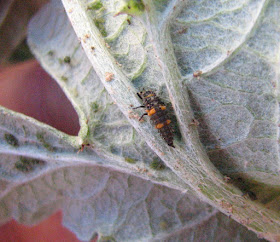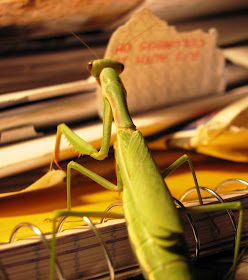As a kid I was fascinated with bugs (to say the least) and I have probably, from egg to egg, raised ladybugs, Anise Swallowtail butterflies, Painted Lady Butterflies, and Praying Mantises with the last being the most difficult. Most insect pests have predators - so it can greatly help to know each kind of beneficial insect (those that eat your insect pests) that lives in your area and how you can use them to minimize your crop damage and work. I would much rather have beneficial insects do the work of eliminating pests for me.
 |
| Grey Aphids can do some damage to the top of plants |
 |
| Aphidius colemani parasitic wasps finding aphids on the leaf |
There are some insect pests whose presence in my garden must be addressed immediately, because of the extent of damage a few can cause and because they have no native predators to bring their population down to numbers that are acceptable to me. These include cucumber beetles, tomato hornworms, squash vine borers, and cutworms. Many of the rest of my pests I rely on beneficial insects to take care of. The most common pest in my garden is aphids. With wings that enable them to fly from one location to another, with ants working hard to protect them (ants harvest nectar from many kinds of aphids), and with the ability to double their population in a matter of days aphids can do a lot of damage to a garden. Their method of attack is sucking juice from the plant, which weakens the plant and can result in leaf curl of both old and new growth. Aphids have many enemies including parasitic wasps, the fuzzy Scymnus beetle larvae, lacewing nymphs, ladybug nymphs and various caterpillars and nymphs of other kinds.
 |
| Aphidius colemani parasitic wasp hatching from prey. |
 |
| Hoverfly Larvae eat aphids. |
 |
| Scymnus beetle larvae enjoy eating aphids too |
| Lacewing Egg on a leaf. |
 |
| Adult Green Lacewing |
My all time favorite of these is the Aphidius colemani parasitic wasp followed by the lacewing. The female A. colemani wasp flies from leaf to leaf, poking her egg laying tube into various aphids to lay eggs in them as she desires. The aphids eventually turn yellow then golden as the new wasp grows within the aphid, then eats it from the inside out. Then the wasp cuts an opening out of the aphid shell and starts the process all over again. Why I love the A. colemani wasp so much is that it can really take the Tucson heat and the ants and aphids just cannot compete with it. I really enjoy lacewings as well. They stay in Tucson throughout the year and are a real help whenever I need a bug to take care of my aphids.
The other beneficial insects I have noted appear in small numbers throughout the year, depending upon how much heat or cold they can tolerate. They complement the A colemani and lacewings but seem to only come in as backup when aphid populations get really high.
 |
| Fast ladybugs are difficult to catch on camera |
| Cabbage Looper caterpillar... |
| ...plus caterpillar Parasitic Wasp... |
| ...equals new home for wasps! |
The only other beneficial insect of note for the garden is the praying mantis, which does well in established gardens. Mantises tend to thrive in long-standing gardens with multiple stories of foliage. This is because they feed on different insects throughout their life cycle. Though they can live in many environments, they prefer eating flying insects and residing on flowering plants that attract insects half the length of their arm. Got all that? Mantises can be difficult to keep in an area, unless you have enough area to support their prey and to keep them safe from larger predators. Many kinds of mantises inhabit Arizona (including Tucson), but the most common variety I find in Tucson is the Mediterranean Mantis, or Iris oratoria.
So how do I attract beneficial insects? The first way I do this is to give them a healthy food source – which means I let the pests thrive. I usually try to start a population of pests and predators early in the spring so that I can enjoy the benefits of beneficial insects all summer and fall. And what if no beneficial insects thrive in my area? I could purchase some varieties from companies that could do well in my climate or I could kill bugs by hand. As for me, I prefer the method with the least work – let the beneficials do the work.







The things I struggle the most with are the aphids - especially when they get inside the broccoli heads - yuk. I never seem to be able to attract enough ladybirds (which are their only native predators in Australia, as far as I know) to deal with them properly.
ReplyDeleteThanks for the reply Liz. I wonder if there are any other beneficial insects that could take care of the aphids in your area. Many beneficial insects do not come out until it is warm enough. Do you get them most when it is cold outside or when it is warm?
DeleteLike Liz I rely on ladybirds to eliminate aphids for us. Aphids the most common problem. The white cabbage butterfly usually around when we have mild weather but I tried to get rid of the egg before it hatches. We have really hot summers and the white cabbage butterfly don't make an appearance during that time.
ReplyDeleteThank you for the comment.
DeleteDo the ladybird beetles stay over the summer? I do love the ladybird beetles but they leave Tucson in the summer when it gets too hot.
Jay, I am also an amateur gardener who is teaching herself more about organic gardening and bugs...I love your blog and am just discovering it after an absence on Blotanical. I will be following your blog for sure...I went to ASU for grad school and my family moved to the suburbs of PHX. I prefer Tucson and the surrounding areas :)
ReplyDeleteThank you so much for the reply Donna! I had some more pictures of the bugs I'd like to add but I just haven't had any time. Yes- I like Tucson better than Phoenix too. It took me a while to even figure out how to spell Phoenix. (=
DeleteTucson is a little more mild of a climate, it has some neat wildlife, and it hasn't grown quite as big as Phoenix - yet. I hope you enjoy your stay in Arizona!
Aphids are the bane in my garden. I wish more beneficials would help out that cause. Thanks for posting the Ladybug larvae. I never saw one in the garden. I am new to visiting your blog and have very much enjoyed this post.
ReplyDeleteWith the weather being in the eighties here in Niagara Falls in mid-March, we are expecting a huge influx of insects this year. They were emerging for weeks now. The weather should cool down again after all the consecutive days of record highs though.
Hello Donna. Thank you for the reply.
DeleteIn some gardens aphids are just a nuisance while in others they can cause some real damage.
The warm weather has really caused some problems for some of the gardeners back east. I hope that the bugs are not too bad this year.
I work for a non-profit in Charlottesville, VA - the Local Food Hub - and was wondering if I could use the first photo in this post (gray aphid infestation) in a pest id slideshow I am creating for farmers in our region. If you are open to this, please let me know how I should credit the photo. Thank you for considering.
ReplyDeleteOh yes - and thank you for asking!
DeleteI hope that if anyone else would like to use any pictures or other material from my website that they would ask before taking.
I greatly appreciate your courtesy. I make it a policy to request permission to use intellectual property before doing so.
Respectfully,
Jay
I'm a Tucson gardener (new) and had a serious aphids problem all summer. I have FINALLY developed a small beneficial population. (Unfortunately i think it was too late Tfor the cucumber and probably for the melon)Your pictures really helped me identify a few beneficials I did not realize I had. Today I found a few small see through worm/caterpillar guys. It looked like one was eating my aphids but I couldn't be sure. Any idea what he might be?
ReplyDeleteThank you for the compliments. The worm/caterpillar guys you refer to are most likely hoverfly larvae. They are very good. Chances are they will all disappear when the weather gets colder.
DeleteI might note that there are some species of aphids that feed on members of the brassica family that sometimes survive through our mild winter so I would watch your broccoli and related plants to make sure you don't get any of those aphids.
How can I tell difference between parasitic wasp and flying black aphid? In photos they look similar.
ReplyDeleteDear Jonathan,
DeleteThank you for your question.
The specific parasitic wasps pictured in this post have similar sized segments while aphids have very large abdomens. Additionally, parasitic wasps generally move in a much more abrupt manner and are often much faster than aphids. In contrast, most aphids move slower and will stop to graze on a specific plant once they find what they are looking for. You can probably get a better view of the picture by clicking on the picture.